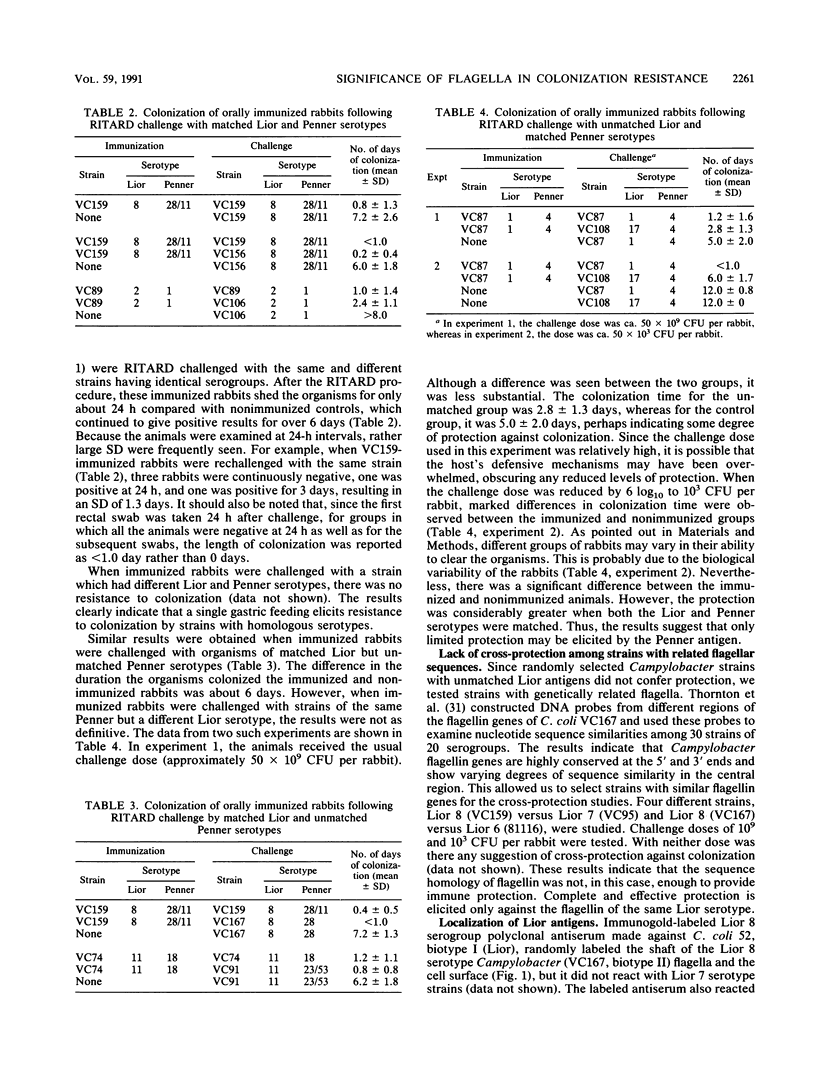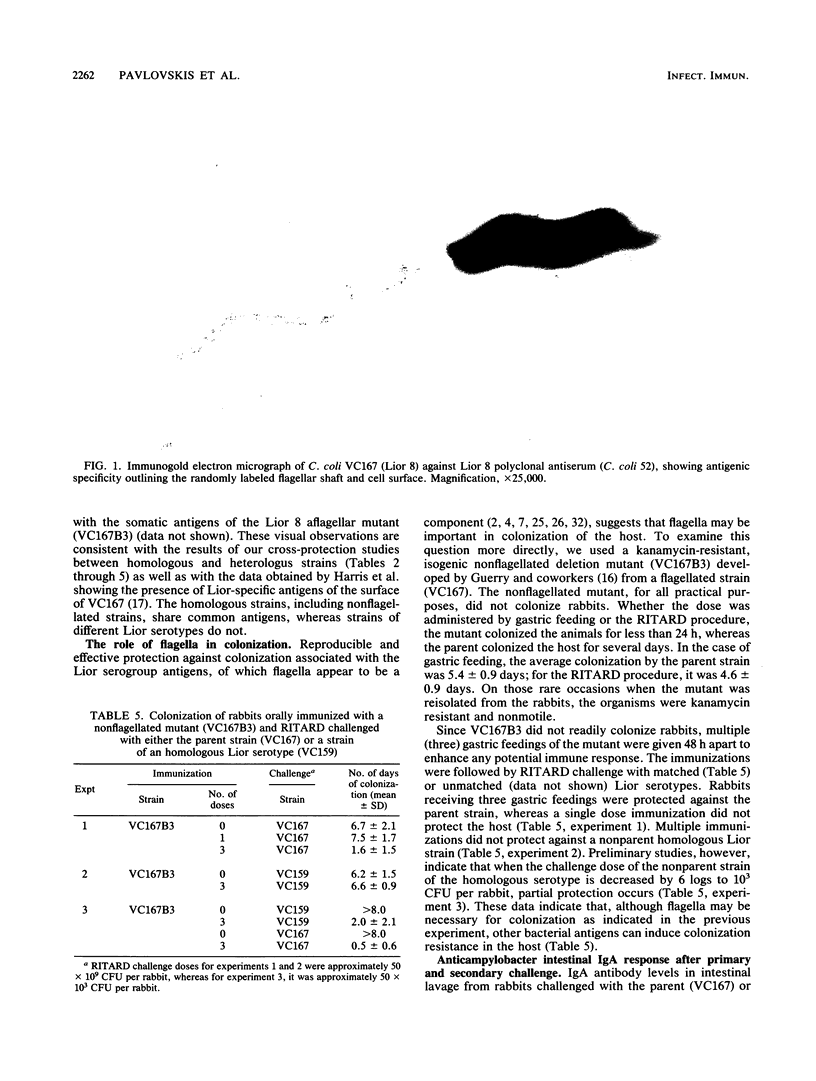Abstract
Cross-protection among different Lior and Penner serogroups of Campylobacter spp. was studied. Rabbits were orally immunized by gastric feeding with Campylobacter spp., and 27 to 30 days later, they were challenged with matched or unmatched serogroups by the removable intestinal tie adult rabbit diarrhea (RITARD) procedure. When immunized animals were challenged with different Lior serotypes, no protection against colonization was seen; however, when challenged with homologous Lior serogroups, protection was demonstrated. Immune animals were colonized for an average of 1 day or less versus at least 6 days for nonimmune animals. Rabbits challenged with matched Penner-unmatched Lior strains showed only marginal protection. Our study also demonstrated that flagella are important in initiating colonization and eliciting protective immunity. Campylobacter coli VC167B3, an isogenic, nonflagellated mutant, did not colonize rabbits regardless of the route of administration. Single feeding of the mutant strain did not protect the host, whereas three feedings, 48 h apart, resulted in complete protection against the flagellated parent strain. When mutant strain immunized rabbits were challenged with other strains of the same Lior serotype, marginal protection was obtained. Immunogold labeling indicated that there is one or more antigens on the cell surface of the nonflagellated mutant which reacts with a polyclonal antiserum from organisms of the same Lior serogroup. These data implicated the flagellum as the cross-strain protective component of the Lior antigen complex.
Full text
PDF





Images in this article
Selected References
These references are in PubMed. This may not be the complete list of references from this article.
- Abimiku A. G., Dolby J. M., Borriello S. P. Comparison of different vaccines and induced immune response against Campylobacter jejuni colonization in the infant mouse. Epidemiol Infect. 1989 Apr;102(2):271–280. doi: 10.1017/s0950268800029940. [DOI] [PMC free article] [PubMed] [Google Scholar]
- Abimiku A. G., Dolby J. M. Cross-protection of infant mice against intestinal colonisation by Campylobacter jejuni: importance of heat-labile serotyping (Lior) antigens. J Med Microbiol. 1988 Aug;26(4):265–268. doi: 10.1099/00222615-26-4-265. [DOI] [PubMed] [Google Scholar]
- Abimiku A. G., Dolby J. M. The mechanism of protection of infant mice from intestinal colonisation with Campylobacter jejuni. J Med Microbiol. 1987 Jun;23(4):339–344. doi: 10.1099/00222615-23-4-339. [DOI] [PubMed] [Google Scholar]
- Aguero-Rosenfeld M. E., Yang X. H., Nachamkin I. Infection of adult Syrian hamsters with flagellar variants of Campylobacter jejuni. Infect Immun. 1990 Jul;58(7):2214–2219. doi: 10.1128/iai.58.7.2214-2219.1990. [DOI] [PMC free article] [PubMed] [Google Scholar]
- Bell J. A., Manning D. D. A domestic ferret model of immunity to Campylobacter jejuni-induced enteric disease. Infect Immun. 1990 Jun;58(6):1848–1852. doi: 10.1128/iai.58.6.1848-1852.1990. [DOI] [PMC free article] [PubMed] [Google Scholar]
- Black R. E., Levine M. M., Clements M. L., Hughes T. P., Blaser M. J. Experimental Campylobacter jejuni infection in humans. J Infect Dis. 1988 Mar;157(3):472–479. doi: 10.1093/infdis/157.3.472. [DOI] [PubMed] [Google Scholar]
- Blaser M. J., Hopkins J. A., Perez-Perez G. I., Cody H. J., Newell D. G. Antigenicity of Campylobacter jejuni flagella. Infect Immun. 1986 Jul;53(1):47–52. doi: 10.21236/ada265460. [DOI] [PMC free article] [PubMed] [Google Scholar]
- Burr D. H., Caldwell M. B., Bourgeois A. L., Morgan H. R., Wistar R., Jr, Walker R. I. Mucosal and systemic immunity to Campylobacter jejuni in rabbits after gastric inoculation. Infect Immun. 1988 Jan;56(1):99–105. doi: 10.1128/iai.56.1.99-105.1988. [DOI] [PMC free article] [PubMed] [Google Scholar]
- Burr D. H., Kerner D. T., Blanco C. S., Bourgeois A. L., Wistar R., Jr Gastric lavage: a simple method to obtain IgA-rich intestinal secretions from the rabbit. J Immunol Methods. 1987 May 20;99(2):277–281. doi: 10.1016/0022-1759(87)90138-4. [DOI] [PubMed] [Google Scholar]
- Caldwell M. B., Guerry P., Lee E. C., Burans J. P., Walker R. I. Reversible expression of flagella in Campylobacter jejuni. Infect Immun. 1985 Dec;50(3):941–943. doi: 10.1128/iai.50.3.941-943.1985. [DOI] [PMC free article] [PubMed] [Google Scholar]
- Caldwell M. B., Walker R. I., Stewart S. D., Rogers J. E. Simple adult rabbit model for Campylobacter jejuni enteritis. Infect Immun. 1983 Dec;42(3):1176–1182. doi: 10.1128/iai.42.3.1176-1182.1983. [DOI] [PMC free article] [PubMed] [Google Scholar]
- Cray W. C., Jr, Tokunaga E., Pierce N. F. Successful colonization and immunization of adult rabbits by oral inoculation with Vibrio cholerae O1. Infect Immun. 1983 Aug;41(2):735–741. doi: 10.1128/iai.41.2.735-741.1983. [DOI] [PMC free article] [PubMed] [Google Scholar]
- Engvall E., Perlmann P. Enzyme-linked immunosorbent assay, Elisa. 3. Quantitation of specific antibodies by enzyme-labeled anti-immunoglobulin in antigen-coated tubes. J Immunol. 1972 Jul;109(1):129–135. [PubMed] [Google Scholar]
- Glass R. I., Stoll B. J., Huq M. I., Struelens M. J., Blaser M., Kibriya A. K. Epidemiologic and clinical features of endemic Campylobacter jejuni infection in Bangladesh. J Infect Dis. 1983 Aug;148(2):292–296. doi: 10.1093/infdis/148.2.292. [DOI] [PubMed] [Google Scholar]
- Guerry P., Logan S. M., Thornton S., Trust T. J. Genomic organization and expression of Campylobacter flagellin genes. J Bacteriol. 1990 Apr;172(4):1853–1860. doi: 10.1128/jb.172.4.1853-1860.1990. [DOI] [PMC free article] [PubMed] [Google Scholar]
- Guerry P., Logan S. M., Thornton S., Trust T. J. Genomic organization and expression of Campylobacter flagellin genes. J Bacteriol. 1990 Apr;172(4):1853–1860. doi: 10.1128/jb.172.4.1853-1860.1990. [DOI] [PMC free article] [PubMed] [Google Scholar]
- Harris L. A., Logan S. M., Guerry P., Trust T. J. Antigenic variation of Campylobacter flagella. J Bacteriol. 1987 Nov;169(11):5066–5071. doi: 10.1128/jb.169.11.5066-5071.1987. [DOI] [PMC free article] [PubMed] [Google Scholar]
- Kang Y. H., Carl M., Watson L. P., Yaffe L. Immunoelectron microscopic identification of human NK cells by FITC-conjugated anti-Leu-11a and biotinylated anti-Leu-7 antibodies. J Immunol Methods. 1985 Nov 28;84(1-2):177–196. doi: 10.1016/0022-1759(85)90426-0. [DOI] [PubMed] [Google Scholar]
- Lee A., O'Rourke J. L., Barrington P. J., Trust T. J. Mucus colonization as a determinant of pathogenicity in intestinal infection by Campylobacter jejuni: a mouse cecal model. Infect Immun. 1986 Feb;51(2):536–546. doi: 10.1128/iai.51.2.536-546.1986. [DOI] [PMC free article] [PubMed] [Google Scholar]
- Lior H., Woodward D. L., Edgar J. A., Laroche L. J., Gill P. Serotyping of Campylobacter jejuni by slide agglutination based on heat-labile antigenic factors. J Clin Microbiol. 1982 May;15(5):761–768. doi: 10.1128/jcm.15.5.761-768.1982. [DOI] [PMC free article] [PubMed] [Google Scholar]
- Logan S. M., Trust T. J., Guerry P. Evidence for posttranslational modification and gene duplication of Campylobacter flagellin. J Bacteriol. 1989 Jun;171(6):3031–3038. doi: 10.1128/jb.171.6.3031-3038.1989. [DOI] [PMC free article] [PubMed] [Google Scholar]
- Logan S. M., Trust T. J. Molecular identification of surface protein antigens of Campylobacter jejuni. Infect Immun. 1983 Nov;42(2):675–682. doi: 10.1128/iai.42.2.675-682.1983. [DOI] [PMC free article] [PubMed] [Google Scholar]
- Martin P. M., Mathiot J., Ipero J., Kirimat M., Georges A. J., Georges-Courbot M. C. Immune response to Campylobacter jejuni and Campylobacter coli in a cohort of children from birth to 2 years of age. Infect Immun. 1989 Aug;57(8):2542–2546. doi: 10.1128/iai.57.8.2542-2546.1989. [DOI] [PMC free article] [PubMed] [Google Scholar]
- Morooka T., Umeda A., Amako K. Motility as an intestinal colonization factor for Campylobacter jejuni. J Gen Microbiol. 1985 Aug;131(8):1973–1980. doi: 10.1099/00221287-131-8-1973. [DOI] [PubMed] [Google Scholar]
- Newell D. G., McBride H., Dolby J. M. Investigations on the role of flagella in the colonization of infant mice with Campylobacter jejuni and attachment of Campylobacter jejuni to human epithelial cell lines. J Hyg (Lond) 1985 Oct;95(2):217–227. doi: 10.1017/s0022172400062653. [DOI] [PMC free article] [PubMed] [Google Scholar]
- Newell D. G. Monoclonal antibodies directed against the flagella of Campylobacter jejuni: production, characterization and lack of effect on the colonization of infant mice. J Hyg (Lond) 1986 Apr;96(2):131–141. doi: 10.1017/s0022172400065906. [DOI] [PMC free article] [PubMed] [Google Scholar]
- Penner J. L., Hennessy J. N. Passive hemagglutination technique for serotyping Campylobacter fetus subsp. jejuni on the basis of soluble heat-stable antigens. J Clin Microbiol. 1980 Dec;12(6):732–737. doi: 10.1128/jcm.12.6.732-737.1980. [DOI] [PMC free article] [PubMed] [Google Scholar]
- Spira W. M., Sack R. B., Froehlich J. L. Simple adult rabbit model for Vibrio cholerae and enterotoxigenic Escherichia coli diarrhea. Infect Immun. 1981 May;32(2):739–747. doi: 10.1128/iai.32.2.739-747.1981. [DOI] [PMC free article] [PubMed] [Google Scholar]
- Ueki Y., Umeda A., Fujimoto S., Mitsuyama M., Amako K. Protection against Campylobacter jejuni infection in suckling mice by anti-flagellar antibody. Microbiol Immunol. 1987;31(12):1161–1171. doi: 10.1111/j.1348-0421.1987.tb01350.x. [DOI] [PubMed] [Google Scholar]
- Walker R. I., Caldwell M. B., Lee E. C., Guerry P., Trust T. J., Ruiz-Palacios G. M. Pathophysiology of Campylobacter enteritis. Microbiol Rev. 1986 Mar;50(1):81–94. doi: 10.1128/mr.50.1.81-94.1986. [DOI] [PMC free article] [PubMed] [Google Scholar]
- Wenman W. M., Chai J., Louie T. J., Goudreau C., Lior H., Newell D. G., Pearson A. D., Taylor D. E. Antigenic analysis of Campylobacter flagellar protein and other proteins. J Clin Microbiol. 1985 Jan;21(1):108–112. doi: 10.1128/jcm.21.1.108-112.1985. [DOI] [PMC free article] [PubMed] [Google Scholar]
- Winsor D. K., Jr, Mathewson J. J., DuPont H. L. Western blot analysis of intestinal secretory immunoglobulin A response to Campylobacter jejuni antigens in patients with naturally acquired Campylobacter enteritis. Gastroenterology. 1986 May;90(5 Pt 1):1217–1222. doi: 10.1016/0016-5085(86)90388-4. [DOI] [PubMed] [Google Scholar]



